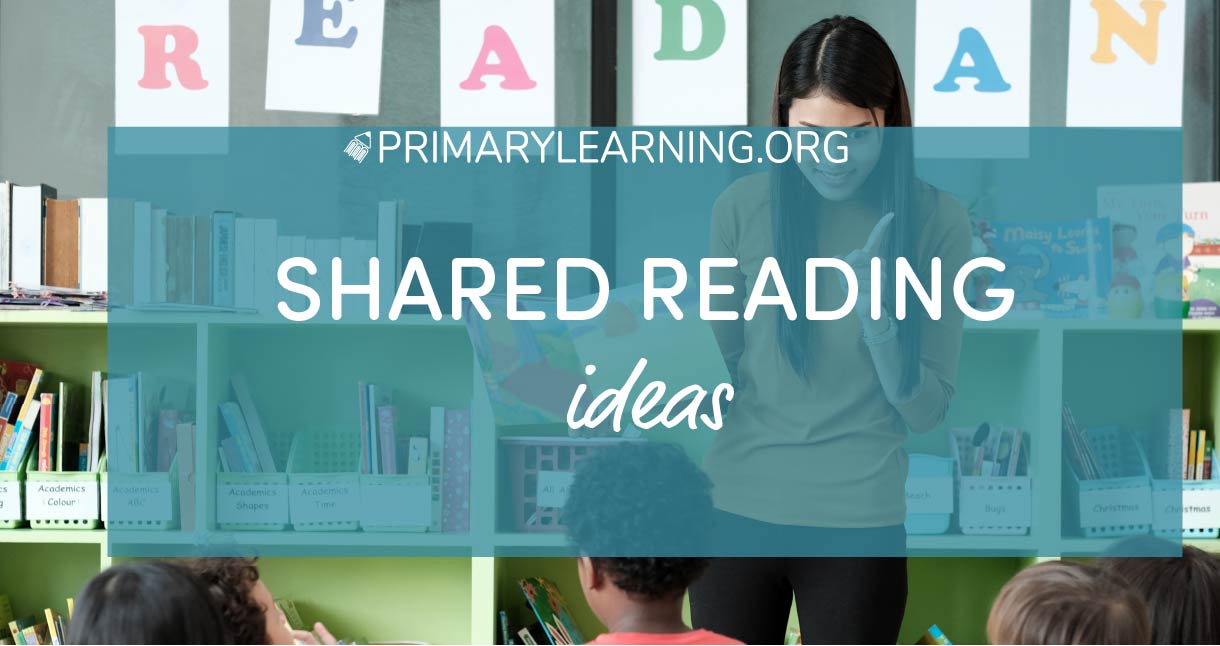

Posted by: Alesia Netuk
Updated: October 2nd, 2023
Shared Reading Ideas
Shared Reading Ideas
Shared reading is an instructional strategy where students join in, reading a text or parts of a text, with the educator. Every student needs to have access to the text, whether it’s a message written on chart paper that everyone can see or a book that each student has a copy of. The educator and the students read the text out loud, together.
Benefits of Shared Reading
Because shared reading is done along with the educator, it is a highly supported form of reading. This assists students who may otherwise struggle with accessing a text that others are reading independently. Shared reading provides all students with opportunities to be confident and successful in their reading.
Shared reading is an effective way to encourage participation by beginning readers. It helps young children begin to develop concepts about print, such as reading left to right, using one-to-one correspondence, and pausing after punctuation.
Educators can use shared reading experiences to focus on a variety of teaching and learning points. For example, educators may use shared reading to model and provide expression and fluency, discuss word solving strategies, or target comprehension. Shared reading of the same text multiple times allows educators to focus on different teaching points during each lesson.
Texts to Use During Shared Reading
Educators can use poems, chants, and rhymes to conduct a shared reading. Because these text forms often contain language patterns, rhyming words, and rhythm, students can join in readily and typically find the texts enjoyable to read. Poems, chants, and rhymes can be written on chart paper for all students to see and used during carpet time. It may be helpful to use a pointer to help students follow along with the words.
Once this strategy is modeled, a student may take over the responsibility of pointing to the words. When choosing poems, chants, and rhymes, educators may select texts based on the current season or an upcoming holiday. Or, they may choose a text based on specific features they wish to introduce students to, like alliteration, bold print, or exclamation marks. The text chosen can be used over multiple days and deconstructed, according to the learning goals.
Morning messages provide another opportunity for shared reading. The educator can carefully construct a message, choosing words and features with intentionality, based on the learning goal. For example, educators may wish to include high-frequency words students have been focusing on.
Or, they may use the morning message to introduce a specific text form, like a letter. Morning messages may include specific punctuation students are learning, like exclamation marks or question marks. Like poems, chants, and rhymes, morning messages can be printed on chart paper, and one-to-one correspondence can be supported by using a pointer as students read. Morning messages can also be deconstructed.
For example, following shared reading, students could be asked to locate certain high-frequency words, circle all the periods, or highlight the uppercase letters.
Big books lend themselves nicely to shared reading experiences. Because of their large size, all students can see the print and pictures. Students are often excited by the novelty of big books and eager to read them. Big books may contain poems, non-fiction articles, or fictitious stories. They provide numerous opportunities to focus on reading strategies, such as making predictions, conducting a recount, and answering comprehension questions.
Educators may also use big books to introduce text features such as diagrams, captions, and glossaries. Beginning readers will benefit from big books with short sentences that follow a predictable pattern. For longer books, students may be asked to chime in during specific portions of the text.
Traditional books can also be used during shared reading. While it’s possible to use them during whole group lessons, they can also focus on small group instruction. Each student is provided with a copy of the book. Because the group is small, the educator can monitor students closely to ensure they can participate fully in the reading. The educator also can work on learning goals tailored specifically to the students in the group.
Shared reading of a book during small group instruction may be a precursor to guided reading. Beginning readers being introduced to a new book may benefit from reading it initially as a shared experience. This may help them to become more confident in their ability to tackle the reading independently. During shared reading, the educator can support word-solving, point out any challenging text features, and model fluent reading of the book. After reading through the book together, students are then asked to read the book independently. This may happen on the same day as the shared reading or the following day.
Components of Shared Reading
Educators may wish to follow before, during, and after reading strategies during shared reading experiences. For example, before beginning to read, educators may ask students to preview a text by reading the title, looking at the pictures, and considering the topic. This is an ideal time to have students tap into their prior knowledge about the topic and make predictions about the text.
During a reading, educators may wish to focus on concepts such as fluency and expression, word solving strategies, understanding vocabulary, and asking questions or posing “wonderings.” After reading, students can engage in activities like confirming predictions, making connections to the text and providing recounts. The benefit of incorporating shared reading into your literacy program is that it provides so many opportunities to focus on many learning goals, all within a supportive framework that promotes student success.
LEARNING MATERIALS TO MEET EVERY CHILD’S NEEDS
Here, at PrimaryLearning.Org, we tend to deliver the best-differentiated learning materials to K-2 students. Our resources can be easily incorporated into multisensory lessons to meet every child’s needs, whether s/he is a visual, kinesthetic, or auditory learner.